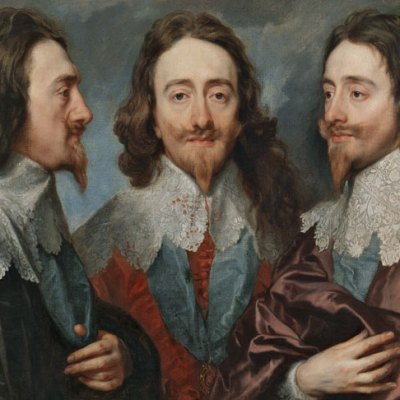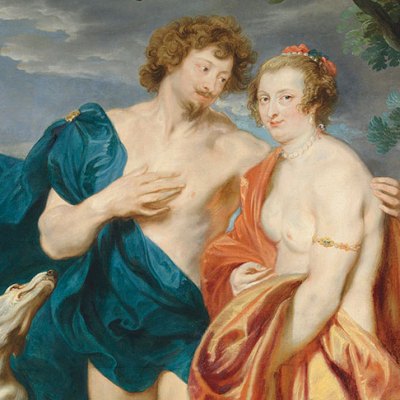From the January 2022 issue of Apollo. Preview and subscribe here.
Gainsborough’s Blue Boy has long been singled out as a work apart. A painter’s showpiece rather than a commissioned work, it received immediate critical acclaim, was emulated by artists and valued by collectors, and the circumstances of its creation were puzzled over by connoisseurs. In 1857, its display at the Manchester Art Treasures Exhibition, at the height of the public cult of Gainsborough, made it a particular object of reverence. Through discussion and reproduction, it became one of the handful of paintings (like the Mona Lisa and Whistler’s Mother) so familiar that it could be joked about in shorthand by people who might never see it. A Victorian fashion columnist mocked the taste for coloured kid gloves in hot weather, having seen an Edinburgh woman turn herself into The Blue Boy when the dye ran; a warehousemen’s trade magazine explained how ‘Gainsborough’s “Blue Boy” would have been bluer than ever if he passed a day in the St. Katharine’s indigo warehouse’ in London. The record-breaking price that the American railway magnate Henry Huntington paid for the painting and the emotive drama of its leave-taking from Britain in 1922 sealed its singular status.
The Blue Boy (1770), Thomas Gainsborough. Huntington Library, Art Museum and Botanical Gardens, San Marino.
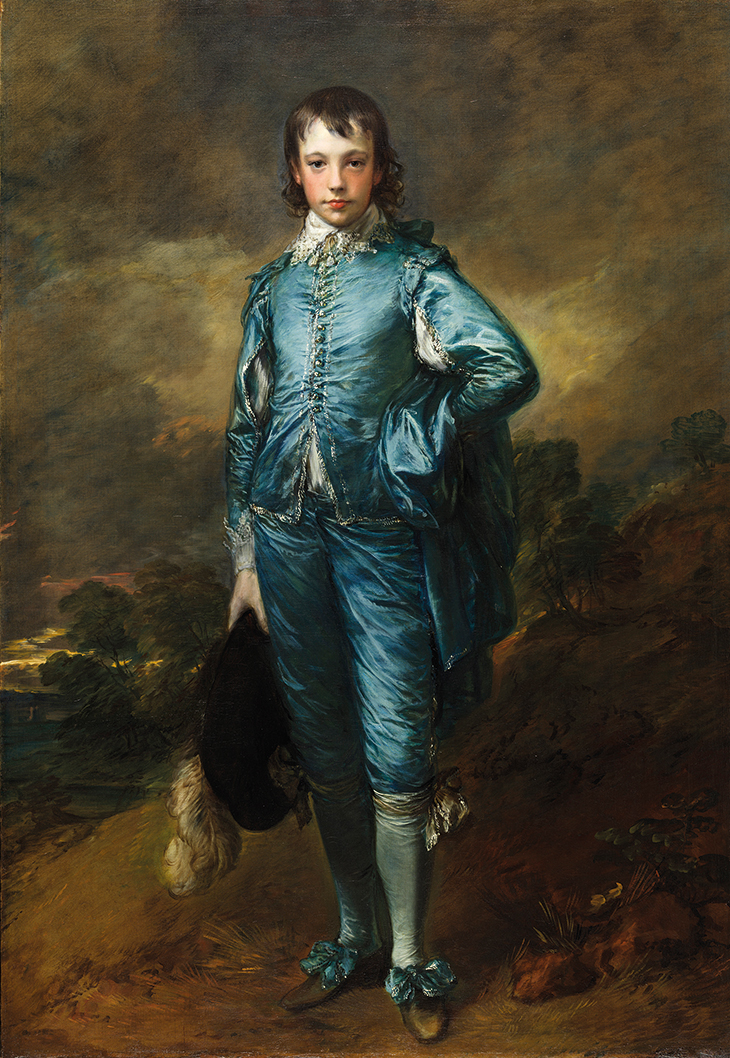
The loan of The Blue Boy to the National Gallery, exactly 100 years after its sensational departure for America, is a chance for the British public to reacquaint itself with one of the artist’s most complex and provocative masterpieces. It will be fascinating to see how this painting, which has come to epitomise particular constructions of the 18th century and of Englishness, resonates in 21st-century Britain.
Gainsborough exhibited the painting at the Royal Academy in 1770 as Portrait of a Young Gentleman. Blurring the boundaries between portraiture and genre painting, it was already being called ‘The Blue Boy’ by 1798. The identity of the sitter is still a matter of debate, but whether he is Jonathan Buttall, the son of a rich ironmonger friend (as long believed) or the artist’s nephew and pupil, Gainsborough Dupont (as recently argued) or someone else entirely, all evidence points to a non-noble teenager striking a princely pose from Anthony van Dyck’s portrait of the Duke of Buckingham in George Villiers, 2nd Duke of Buckingham and his Brother, Lord Francis Villiers, then at Buckingham Palace.
Dressing up in and being portrayed in ‘Vandyke’ masquerade was commonplace in Gainsborough’s Britain – a few examples of such fancy-dress costumes, in satin, braid and sequins, survive – but with The Blue Boy the artist is also performing a painterly masquerade and making a statement about his relationship to the art of the past, and about his modernity. As well as pose and gesture, Gainsborough invokes the colourism and radiance, the sense of speed and vigour in the brushwork and the eloquent drapery of the Anglo-Flemish painter, whom he considered the supreme exponent of British portraiture and against whose measure he asks The Blue Boy to be judged. The historical clothing is transposed into something akin to the late 18th-century English suit, which follows the form of the body, allowing easy movement and suggesting honesty and comfort; in Van Dyck’s satins, by contrast, pockets of air, integral to the way the fabric is woven, amplify the expressive movement of the drapery around and away from the body. As well as encouraging comparisons with Van Dyck (and Titian and Rubens), Gainsborough draws upon more recent French innovations in art; he calls to mind the belief of the painter and critic Roger de Piles that the spectator is affected not by what is represented but by the manner of the representation.
George Villiers, 2nd Duke of Buckingham (1628–87) and Lord Francis Villiers (1629–48) (1635), Anthony van Dyck. Royal Collection Trust. © Her Majesty Queen Elizabeth II 2021

The contemporary viewer may be reminded of Jean-Antoine Watteau’s Pierrot (c. 1718–19), another solitary figure in fancy dress, whose scale, pose and format seem to anticipate The Blue Boy. In fact, Gainsborough could not have known Watteau’s painting (unless by report: it had not yet been reproduced and, as far as we know, there was no copy in England), but the resonance between the two helps make clear how The Blue Boy incorporates elements of the fête galante and that genre’s seductive, subversive blurring of the boundaries between make-believe and reality on the one hand and theatre and social performance on the other, along with a portrayal of clothing that is not a trustworthy marker of identity and class. The Blue Boy’s performative virtuosity and the way it plays with codes of portraiture and social distinction in an act of masquerade recall other French 18th-century portrait modes too, notably Jean-Honoré Fragonard’s portraits de fantaisie of 1769.
Portraits gain meaning from their visual and historical associations, and for all The Blue Boy’s celebrity and self-confident command of his canvas – space behind and around him, his foot nearly touching the picture plane, the facial symmetry and fixed, forward gaze – he is not entirely a boy apart. There is a whole gang of ‘Vandyke’ boys (and men), which collectively illuminate themes of childhood, adolescence and masculinity, dress and the manufacture and politics of silk and satin, deepening our understanding of Gainsborough’s playful, searching mastery of the conventions of portraiture.
Master Francis Nicholls (‘The Pink Boy’) (1782; before cleaning), Thomas Gainsborough. Waddesdon Manor. Photo: Waddesdon Image Library/The Public Catalogue Foundation/Art UK
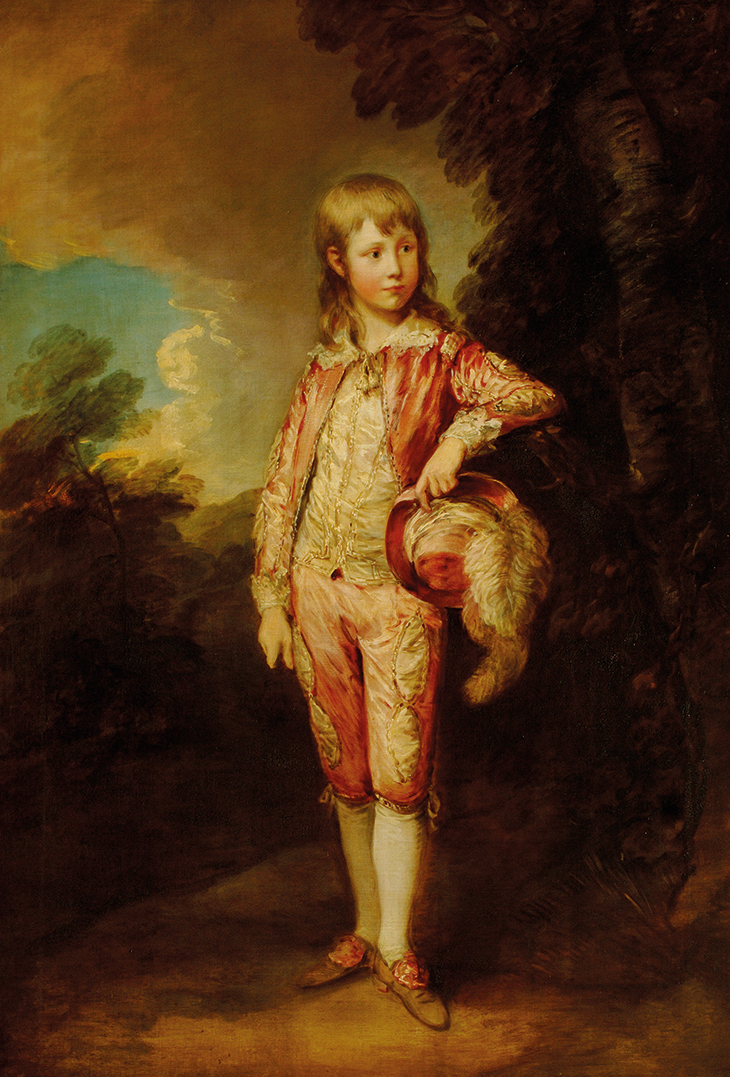
Twelve years after The Blue Boy was exhibited, the shimmering full-length known as The Pink Boy (1782), now at Waddesdon Manor, was created, perhaps as another showpiece. The non-standard-sized canvas has proportions similar to those of The Blue Boy and, as with that earlier work, Gainsborough made several changes to the painting as he went along. The subject is younger than his teenage counterpart. The pink costume is reflected in the cheeks, which, with their more delicate colouring and pale upper sections, are distinctly less blood-flushed and much more youthful. The pose is adapted to create a different emotional mood. Shyness replaces swagger. The Pink Boy holds his hat in front of him, whereas the Blue Boy’s hand is on his hip beneath the cloak. He leans into the shelter of a tree in a generally more enclosing landscape. Even before its current cleaning is completed, the bright blue in the sky is clear, in contrast to the storm clouds massing behind the Blue Boy.
The Pink Boy was shown at the Royal Academy the same year as Gainsborough’s George, Prince of Wales (1782), whose general pose and left arm holding a hat is just one shared compositional element that would have underlined for visitors the natural dignity and touching irony of a child adopting the pose of a grown-up prince. The boy was identified at the time as ‘Master Nicholls, the grandson of Dr. Nicholls’. A famous anatomist, Dr Frank Nicholls (1699–1778) had married the daughter of the physician and collector Dr. Richard Mead, who, intriguingly, had treated Watteau in London and commissioned paintings from him. The Pink Boy’s father was John Nicholls, elected MP for Bletchingley in Surrey the year after Gainsborough completed this work. The Pink Boy acquired its nickname in the 19th century, in the wake of The Blue Boy’s fame.
Alexander Douglas-Hamiltn (1767–1852), 10th Duke of Hamilton, 7th Duke of Brandon (1786), Thomas Gainsborough. Waddesdon Manor. Photo: Waddesdon Image Library/The Public Catalogue Foundation/Art UK

Whatever the circumstances of its creation – a commission for the son of a man on the rise, or another genre-blurring demonstration of Gainsborough’s place in a European lineage of painters of silk, flesh and light – Nicholls is a different kind of boy and this is a different kind of painting from the pair of portraits that hang opposite him in the Morning Room at Waddesdon, both painted in 1786. For these aristocratic brothers, sons of the 9th Duke of Hamilton, their ‘Vandyke’ dress enforces their dynastic standing; the differentiation between their two costumes distinguishes their relative age and rank. Lord Alexander Douglas-Hamilton, the future duke – his gaze disengaged from the viewer’s – wears black and white, the fabrics stiffer and flatter than his brother’s, reminiscent of the austere but costly black dress of Spanish noblemen. The collar was originally plain: the lace added later to match his brother’s. The monochrome palette recalls portraits of his forbears by Van Dyck and Daniel Mytens. Lord Archibald’s take on 17th-century dress is lustrous blue. The dynamic brushstrokes of the lace collar are all of a piece with those that articulate the movement and lustre of the silk. In the early 18th century the artist Jonathan Richardson the Elder described how ‘in a piece of silk […] there must be lesser folds, breakings, flickerings and reflection, and the great mass yet evidently preserved.’
Lord Archibald Hamilton (1770–1827) (1786), Thomas Gainsborough. Waddesdon Manor. Photo: Waddesdon Image Library/The Public Catalogue Foundation/Art UK

Alexander’s black historic costume linked him to his royalist ancestor the 1st Duke of Hamilton, who died on the same scaffold as Charles I; Archibald’s dress, on the other hand – varying only slightly from that worn by the Blue Boy and probably a well-used studio prop – is, as modern dress-up, appropriate to his relative freedom from the responsibilities of maturity, the pleasures of which are communicated by his smiling mouth and eyes. His long hair is that of a Cavalier but is also in keeping with the un-trussed informality with which even the children of dukes impressed foreign visitors.
‘Vandyke’ dress as a signifier of youth is found again in Gainsborough’s portrait of the Hon. Edward Bouverie, fourth son of the 1st Earl of Radnor (1773). The 13-year-old stands out from a sequence of portraits at Longford Castle in which he is the last and youngest. The earl starts the series, with a Van Dyck pose, his body in profile, cloaked in distinctly classical drapery, his own clothes just visible at the neck. As the portraits move from father to his three sons by his second wife, in order of age, the classical drapery falls away. The precedence of the eldest, William Henry, is again expressed by an elevated gaze and upright neck. The middle son, Bartholomew, more relaxed, looks out at the viewer. They wear, respectively, yellow and blue coats, which at first sight seem modern, as does their hair, but the tabbing and slashing of the sleeves introduces the subtlest 17th-century note. It is only when the series reaches Edward that Gainsborough expands the ‘Vandyke’ theme and familiar blue coat, with its epaulettes, silver-edged slashing and dog-toothed collar and cuffs. Edward is seen front on, though his face is turned slightly off centre, his eyes askance, as though distracted from the sitting, perhaps daydreaming. Unlike his father and brothers, whose hands are not seen and whose poses are static, Edward’s clasped hands, their fingers full of touch and motion, lead the eye to the books beneath his left arm, which mark him as a student, still in formation. If the Blue Boy confronts the viewer with his physicality, Gainsborough shows Bouverie contained within his own mind.
The adolescent body and mind were of concern to 18th-century thinkers. John Locke had considered the passage from boyhood to manhood ‘the most hazardous step in all the whole course of Life’, and in 1782 the judge-philosopher Lord Kames wrote of ‘puberty, when new appetites and desires spring up’ as the ‘most critical time for education’. Reflecting the ideas of Jean-Jacques Rousseau, educationalists increasingly saw fantasy and play as natural tools in the management of this liminal phase between childhood and maturity and the moulding of young people into gentility. While the oak leaves carved into the Bouverie portraits’ fictive roundels emphasise the Englishness and age of a newly ennobled Huguenot family with mercantile roots, the ‘Vandyke’ portrayal of the youngest son suggests possibility and transformation.
The linked differentiation of ‘Vandyke’ boys is found again in two portraits of Gainsborough’s nephews Edward Richard Gardiner (c. 1772) and Gainsborough Dupont (c. 1770) – both oval in format, spontaneous and unfinished, the ground visible in many places, showing off the speed with which the artist created the illusion of form and presence with his zigzags, sweeps and veils of paint. The animated brushwork that conjures up the clothing is a foil for the higher finish and stillness of the sitters’ heads and their neutral facial expressions. Gainsborough Dupont is depicted at around the age of 16, Edward Gardiner at around eight. These are intimate studies of members of the artist’s family, intense observations of the stages of boyhood on either side of the onset of puberty, the head-and-shoulder focus inviting the viewer to confront their individuality and inner consciousness. With these portrayals of members of his own family in The Blue Boy costume, as with The Blue Boy itself and The Pink Boy, Gainsborough plays with the fluid relationship between clothing and identity.
However, it is not only boys who don these flamboyant costumes for Gainsborough. Sir Charles Holte is about 50 in a portrait presumably painted (c. 1770) to mark his ascendancy from impoverished younger sibling to rich baronet after the death of his brother Lister, with whom he had had bitter arguments about money. They had been painted together in childhood, Lister in pink and Charles in blue. The sibling acrimony may provide a context for understanding the costume choice for this middle-aged younger brother, although it has also been suggested that Sir Charles’s Stuart-style clothing alludes to his ancestors’ royalist sympathies during the Civil War.
Charles Howard, 11th Duke of Norfolk (1784–86/87), Thomas Gainsborough. National Portrait Gallery, London (on long-term loan to Arundel Castle). Photo: © National Portrait Gallery, London
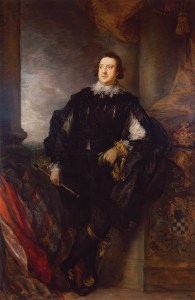
By the time of this portrait the more recent Stuart threat from the Jacobites was sufficiently neutralised for even the Hanoverian George III to have himself and his family depicted in Stuart masquerade (the painting was done by Johan Zoffany in 1770, and displayed at the RA the same year as The Blue Boy). Harking back to an (imagined) age of gallantry and glamour, the re-imagining of the dress of the Caroline court also lent the weight of the past to the most public fashioning of certain sitters. Gainsborough’s portrait of Charles Howard, 11th Duke of Norfolk (1784–86/87) – now in the National Portrait Gallery collection, but on long-term loan to Arundel Castle – exploits the power of Van Dyck at his most baroque, with the fictive architecture and accoutrements of status. Howard inherited the dukedom while the portrait was in progress, requiring the addition of baton, coat of arms, peer’s robes and coronet. The black ‘Vandyke’ dress – the sitter’s choice – was there from the start. Like Alexander Douglas-Hamilton’s historicising black clothes, Howard’s emphasised the length and continuity of his lineage rather than suggesting a fashionable partygoer, although since some commentators thought the costume distracted from the likeness, the gravitas may not have trumped the masquerade.
Bernard Howard, 12th Duke of Norfolk (1788), Thomas Gainsborough. Arundel Castle, Norfolk. Photo: Paul Barker; by kind permission of the Duke of Norfolk
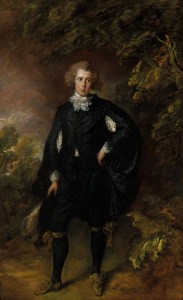
The 11th Duke knew that the title would pass, indirectly, to his third cousin Bernard Howard, whom Gainsborough painted wearing another black (simplified) ‘Vandyke’ costume to assert this line of descent. These two men in black could hardly be more different, however. Unlike the proudly powerful pose in pillared setting of his predecessor, Bernard Howard, future 12th Duke of Norfolk (1788), is visualised in a clever synthesis of the familiar Van Dyck conventions, translated into a man of Sensibility, alone in a landscape, apparently unaware of the viewer’s scrutiny, his expression thoughtful, even troubled. The ‘Vandyke’ dress links one duke with another, backwards into history. Gainsborough’s immediately recognisable manner of painting in a quintessential example of his distinctive treatment of a figure in a landscape, whose tones and textures enhance the emotional register (reminiscent of the similarly French-inflected Mrs Richard Brinsley Sheridan, 1785–87), stamps with modernity this duke of the future.
The dukes of Norfolk navigated paths between great power and institutional exclusion. They were the highest nobles in the land but, as Catholics, faced restrictions of all kinds, including exclusion from the universities. The 11th Duke renounced his faith after the anti-Catholic Gordon Riots of 1780; the 12th Duke did not, and was a key player in the fight for Catholic emancipation long into the next century – just one of the circumstances that shows how Gainsborough manipulated codes of portraiture to embed associations and new meanings in his works.
It is Gainsborough’s ‘Vandyke’ boys rather than men, however, which achieved the most lasting afterlife, none more so than The Blue Boy, still explored and exploited in painting, film and popular culture. The boys pop up all over the place in Victorian art. A century after The Blue Boy was first exhibited, Alfred Morgan introduced a version of him – but younger, softer and unselfconscious; a particular, non-hormonal idea of the ‘natural’ – in his lunette Sketching from Nature for the National Competition Gallery of the South Kensington Museum. It brings together figures and art from different periods to tell new stories about British culture and identity in the imperial age. William Frederick Yeames harnessed the fame of The Blue Boy for the protagonist in his treatment of an imaginary 17th-century past, And When Did You Last See Your Father? (1878). However, his – blond – blue boy, made Christ-like in pose and innocence, is closer in age to the Pink Boy, small enough that he needs to stand on a footstool to reach the eye-line of his interrogator. So here we have the recollection of an 18th-century boy in 17th-century fancy dress being used to imbue an idea of historical authenticity and raw sentimental force into a 19th-century reimagining of English history; evidence of the compelling power and protean nature of Gainsborough’s boys in ‘Vandyke’ dress.
‘Gainsborough’s Blue Boy’ is at the National Gallery, London, from 25 January–15 May. The Pink Boy is currently being cleaned and will be displayed at Waddesdon Manor, with other Gainsborough boys in ‘Vandyke’ costume from the Rothschild Collection, this spring.
From the January 2022 issue of Apollo. Preview and subscribe here.

